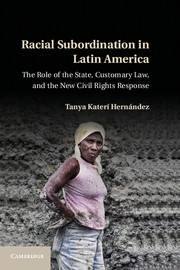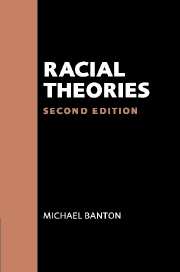Racial Subordination in Latin America: The Role of the State, Customary Law, and the New Civil Rights Response
Cambridge University Press
October 2012
254 pages
2 maps; 1 table
228 x 152 mm
Hardback ISBN: 9781107024861
Paperback: 9781107695436
Adobe Ebook Reader ISBN: 9781139786676
Tanya Katerí Hernández, Professor of Law
Fordham University, New York

There are approximately 150 million people of African descent in Latin America yet Afro-descendants have been consistently marginalized as undesirable elements of the society. Latin America has nevertheless long prided itself on its absence of U.S.-styled state-mandated Jim Crow racial segregation laws. This book disrupts the traditional narrative of Latin America’s legally benign racial past by comprehensively examining the existence of customary laws of racial regulation and the historic complicity of Latin American states in erecting and sustaining racial hierarchies. Tanya Katerí Hernández is the first author to consider the salience of the customary law of race regulation for the contemporary development of racial equality laws across the region. Therefore, the book has a particular relevance for the contemporary U.S. racial context in which Jim Crow laws have long been abolished and a “post-racial” rhetoric undermines the commitment to racial equality laws and policies amidst a backdrop of continued inequality.
Features
- Provides a comprehensive examination of the entire Latin American region with regard to racial inequality
- Hernández is the first author to thoroughly consider the role of customary law in erecting and sustaining racial hierarchies
- Offers a comprehensive examination of development of racial equality laws across the region
Contents
- Maps
- 1. Racial Innocence and the Customary Law of Race Regulation
- 2. Spanish America Whitening the Race – the Un(written) Laws of Blanqueamiento and Mestizaje
- 3. Brazilian “Jim Crow”: The Immigration Law Whitening Project and the Customary Law of Racial Segregation – a Case Study
- 4. The Social Exclusion of Afro-Descendants in Latin America Today
- 5. Afro-Descendant Social Justice Movements and the New Antidiscrimination Laws
- 6. Brazil: At the Forefront of Latin American Race-Based Affirmative Action Policies and Census Racial Data Collection
- 7. Conclusion: The United States–Latin America
- Connections
- Appendix A: Afro-Descendant Organizations in Latin America
- Appendix B: Typology of Latin American Racial Antidiscrimination Measures
- Bibliography
- Index
I don’t think there is much racism in [Latin] America because we are a mix of races of all kinds of Europeans, Africans, Asians, and other races that were or will be; but I understand that in many other parts there is racism, above all in the United States and Europe, is where there is the most racism.1
There are approximately 150 million people of African descent in Latin America, representing about one-third of the total population (see Maps 1 and 2). Yet, these are considered conservative demographic figures given the histories of undercounting the number of persons of African descent on Latin American national censuses and often completely omitting a racial/ethnic origin census question. At the same time, persons of African descent make up more than 40 percent of the poor in Latin America and have been consistently marginalized and denigrated as undesirable elements of the society since the abolition of slavery across the Americas. Yet, the view that “racism does not exist” is pervasive in Latin America despite the advent of social justice movements and social science researchers demonstrating the contrary. When the BBC surveyed Latin Americans in 2005 regarding the existence of racism, a significant number of respondents emphatically denied the existence of racism. Many, for instance, made statements such as “Ibero-Americans are not racist,” and “Ibero-America is not a racist region, for the simple fact that the majority of the population is either indigenous, creole, or mixed.”
Thus the denial of racism is rooted in what many scholars have critiqued as the “myth of racial democracy” – the notion that the racial mixture (mestizaje/mestiçagem) in a population is emblematic of racial harmony and insulated from racial discord and inequality. Academic scholarship has in the last twenty years critiqued Latin American “mestizaje” theories of racial mixture as emblematic of racial harmony. Yet, Latin Americans still very much adhere to the notion that racial mixture and the absence of Jim Crow racial segregation are such a marked contrast to the U.S. racial history that the region views itself as what I term “racially innocent.” Indeed, the extensive survey data from the Latin American Public Opinion Project’s “Americas Barometer 2010” demonstrates that biased Latin American racial ideologies have not completely evolved despite the existing scholarly critiques of mestizaje as a trope of racial innocence. For instance, in the Americas Barometer 2010 survey of Bolivia, Brazil, Colombia, Dominican Republic, Ecuador, Guatemala, Mexico, and Peru, the vast majority of the country populations (of all races) agreed with the mestizaje notion that “racial mixture is good for the country.” In fact, more than 75 percent of all respondents agreed with the statement and largely endorsed the idea of interracial marriages. Yet, the Americas Barometer data also show that for those Latin Americans who did express disagreement with the idea of their children marrying black partners, the opposition level was dramatically greater from white respondents in contrast to black respondents. Specifically, in those countries where the Americas Barometer asked whether there was disagreement with one’s own children marrying a black person, such as Brazil, Colombia, the Dominican Republic, and Ecuador, the opposition by whites to interracial black marriages was on average 60 percent greater than the opposition of blacks to such marriages. (Other countries were asked about marriage to a person of indigenous descent.) These results thus accord with the long-standing data that marriage patterns in Latin America are generally racially endogamous.
The Americas Barometer 2010 data also indicate that white respondents in several Latin American countries are considerably more likely than other groups to state a preference for lighter skin. For instance, in Colombia, Ecuador, and the Dominican Republic, on average 26 percent of white respondents agreed that they would prefer lighter skin, in contrast to the 13 percent average of black respondents who prefer lighter skin. In Mexico and Peru, blacks on average had greater rates of preference for lighter skin (37%) than whites (26%). In Brazil the rate of white preference for lighter skin closely approximated blacks’ lighter-skin preference rate. Even socialist Cuba continues to manifest a preference for whiteness and a white opposition to interracial marriage. Moreover, in a 2004 comparison of implicit and explicit racial bias in the United States, Cuba, the Dominican Republic, and Puerto Rico, the rates of both implicit and explicit racial bias were higher in all three Latin American contexts as compared to the United States. Thus despite the overwhelming articulation of mestizaje as an indicator of racial harmony across much of Latin America and the different ways that it is articulated within each country, attitudes of racial distinction and superiority persist beneath the celebration of racial mixture. In part, the absence of a legal critique of the Latin American comparisons to the Jim Crow United States has enabled the Latin American “racial innocence” stance to remain. This book seeks to fill in that gap in the literature and provide the legal critique.
Specifically, this book is about the ways in which the Latin American denial of racism operating in conjunction with the notion that true racism can only be found in the racial segregation of the United States veils the actual manifestations of racism in Latin America. I will argue that an examination of the role of the state after the abolition of slavery in regulating race through immigration law and customary law disrupts this picture of Latin America as “racially innocent.” I will then assess the ways in which the contemporary Latin American antidiscrimination laws seek to eradicate the legacy of racial inequality wrought by the historic racism of the state. Finally, I will conclude the book with insights as to how the examination of the Latin American context may be helpful to the U.S. racial justice movement today, given the growing denial of the existence of racism in the United Sates. In doing so, I shall adopt the term “Afro-descendants,” which Latin American race scholars and social justice movement actors use to encompass all persons of African descent in Latin America who are affected by antiblack sentiment whether or not they personally identify as “black” or adopt a mixed-race identity such as mulatto or mestizo. This book will not focus upon the racial inequality issues of indigenous groups in Latin America given the extensive literature that already exists regarding that topic. Instead the analysis will focus upon the particular history of Afro-descendants’ relationship to the state as formerly enslaved subjects seeking visibility as citizens and full participants in the national identity despite the societal denial of racism…





